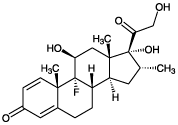Replaces Prod. #: ALX-370-002
Anti-inflammatory glucocorticoid with anti-inflammatory activity. Induces the production of phospholipase A2 inhibitory protein (lipocortin). Inhibits induction of nitric oxide synthase (NOS) (IC50=5nM). Induces apoptosis in eosinophils, but inhibits it in neutrophils. Both effects are blocked by RU-486. Modulates osteogenesis of mesenchymal stem cells. Inhibits constitutive OPG mRNA steady-state levels in a dose- and time-dependent fashion, promoting osteoclast formation. Oral dexamethasone administration induces an increase in insulin resistance in humans. Furthermore, it inhibits differentiation of immature to mature dendritic cells.
Product Details
| Alternative Name: | 9α-Fluoro-16α-methylprednisolone |
| |
| Formula: | C22H29FO5 |
| |
| MW: | 392.5 |
| |
| CAS: | 50-02-2 |
| |
| MI: | 14: 2943 |
| |
| RTECS: | TU3980000 |
| |
| Purity: | ≥98% (HPLC) |
| |
| Appearance: | White to off-white solid. |
| |
| Solubility: | Soluble in DMSO (25mg/ml), 100% ethanol (25mg/1.6ml) or methanol; insoluble in water. |
| |
| Shipping: | Ambient Temperature |
| |
| Long Term Storage: | Ambient |
| |
| Use/Stability: | Stable for up to 5 years after receipt when stored at +20°C. Stock solutions are stable for up to 3 months at -20°C. |
| |
| Handling: | Protect from light. |
| |
| Regulatory Status: | RUO - Research Use Only |
| |
Please mouse over
Product Literature References
In Vitro Tracking of Human Umbilical Vein Endothelial Cells Using Ultra-Sensitive Quantum Dot-Embedded Silica Nanoparticles: J. Kim, et al.; Int. J. Mol. Sci.
24, 5794 (2023),
Abstract;
Localized drug delivery graphene bioscaffolds for cotransplantation of islets and mesenchymal stem cells: M. Razavi, et al.; Sci. Adv.
7, eabf9221 (2021),
Abstract;
Cytokinin transfer by a free-living mirid to Nicotiana attenuata recapitulates a strategy of endophytic insects: C. Brutting, et al.; Elife
7, e36268 (2018),
Abstract;
Full Text
Micelle-templated, poly(lactic-co-glycolic acid) nanoparticles for hydrophobic drug delivery: G.M. Nabar, et al.; Int. J. Nanomedicine
13, 351 (2018),
Abstract;
Full Text
Local release of dexamethasone from macroporous scaffolds accelerates islet transplant engraftment by promotion of anti-inflammatory M2 macrophages: K. Jiang, et al.; Biomaterials
114, 71 (2017),
Abstract;
Changes in cytokinins are sufficient to alter developmental patterns of defense metabolites in Nicotiana attenuata: C. Brütting, et al.; Plant J.
89, 15 (2016),
Application(s): Inducible gene expression in plants,
Abstract;
Full Text
Liver-targeted antiviral peptide nanocomplexes as potential anti-HCV therapeutics: J. Zhang, et al. ; Biomaterials
70, 37 (2015),
Application(s): Cell Culture,
Abstract;
Reconfigurable Hybrid interface for molecular marker diagnostics and in-situ reporting: K. Ehrhardt, et al.; Biosens. Bioelectron.
74, 744 (2015),
Application(s): Cell Culture,
Abstract;
Reverse signaling through GITR ligand enables dexamethasone to activate IDO in allergy: U. Grohmann, et al.; Nature Medicine
13, 579 (2007),
Abstract;
Dexamethasone suppresses eNOS and CAT-1 and induces oxidative stress in mouse resistance arterioles: S.C. Schafer, et al.; Am. J. Physiol. Heart Circ. Physiol.
288, H436 (2005),
Abstract;
Full Text
Dexamethasone prevents granulocyte-macrophage colony-stimulating factor-induced nuclear factor-kappaB activation, inducible nitric oxide synthase expression and nitric oxide production in a skin dendritic cell line: A.L. Vital, et al.; Mediators Inflamm.
12, 71 (2003),
Abstract;
Molecular mechanisms underlying dexamethasone inhibition of iNOS expression and activity in C6 glioma cells: J. Shinoda, et al.; Glia
42, 68 (2003),
Abstract;
Dexamethasone inhibits inducible nitric-oxide synthase expression and nitric oxide production by destabilizing mRNA in lipopolysaccharide-treated macrophages: R. Korhonen, et al.; Mol. Pharmacol.
62, 698 (2002),
Abstract;
Full Text
Dexamethasone suppresses iNOS gene expression by inhibiting NF-kappaB in vascular smooth muscle cells: M. Matsumura, et al.; Life Sci.
69, 1067 (2001),
Abstract;
Dexamethasone inhibits the phosphorylation of retinoblastoma protein in the suppression of human vascular smooth muscle cell proliferation: T.D. Reil, et al.; J. Surg. Res.
92, 108 (2000),
Abstract;
Activation of human O6-methylguanine-DNA methyltransferase gene by glucocorticoid hormone: T. Biswas, et al.; Oncogene
18, 525 (1999),
Abstract;
Dexamethasone induces apoptosis in human T cell clones expressing low levels of Bcl-2: M.S. Montani, et al.; Cell Death Differ.
6, 79 (1999),
Abstract;
Dexamethasone-induced thymocyte apoptosis: apoptotic signal involves the sequential activation of phosphoinositide-specific phospholipase C, acidic sphingomyelinase, and caspases: M.G. Cifone, et al.; Blood
93, 2282 (1999),
Abstract;
Full Text
Induction of the alkyltransferase (MGMT) gene by DNA damaging agents and the glucocorticoid dexamethasone and comparison with the response of base excision repair genes: T. Grombacher, et al.; Carcinogenesis
17, 2329 (1996),
Abstract;
Opposing effects of glucocorticoids on the rate of apoptosis in neutrophilic and eosinophilic granulocytes: L.C. Meagher, et al.; J. Immunol.
156, 4422 (1996),
Abstract;
Dexamethasone and etoposide induce apoptosis in rat thymocytes from different phases of the cell cycle: H.O. Fearnhead, et al.; Biochem. Pharmacol.
48, 1073 (1994),
Abstract;
Dexamethasone inhibits the expression of an inducible nitric oxide synthase in infarcted rabbit myocardium: R.R. Dudek, et al.; BBRC
202, 1120 (1994),
Abstract;
Nitric oxide mediates tumor necrosis factor-alpha cytotoxicity in endothelial cells: C. Estrada, et al.; BBRC
186, 475 (1992),
Abstract;
Glucocorticoids inhibit the induction of nitric oxide synthase and the related cell damage in adenocarcinoma cells: K.J. O'Connor & S. Moncada; Biochim. Biophys. Acta
1097, 227 (1991),
Abstract;
Inhibition of the induction of nitric oxide synthase by glucocorticoids: yet another explanation for their anti-inflammatory effects?: S. Moncada & R.M.J. Palmer; TIPS
12, 130 (1991), (Review),
Abstract;
Differential effects of aspirin and dexamethasone on phospholipase A2 and C activities and arachidonic acid release from endothelial cells in response to bradykinin and leukotriene D4: M.A. Clark, et al.; Prostaglandins
32, 703 (1986),
Abstract;
Dexamethasone-induced insulin resistance enhances B cell responsiveness to glucose level in normal men.: J.C. Beard; Am. J. Physiol.
247, E592 (1984),
Abstract;
Related Products












